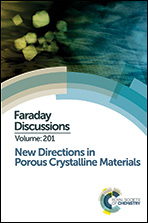Efficiently mapping structure–property relationships of gas adsorption in porous materials: application to Xe adsorption†
Abstract
Designing better porous materials for gas storage or separations applications frequently leverages known structure–property relationships. Reliable structure–property relationships, however, only reveal themselves when adsorption data on many porous materials are aggregated and compared. Gathering enough data experimentally is prohibitively time consuming, and even approaches based on large-scale computer simulations face challenges. Brute force computational screening approaches that do not efficiently sample the space of porous materials may be ineffective when the number of possible materials is too large. Here we describe a general and efficient computational method for mapping structure–property spaces of porous materials that can be useful for adsorption related applications. We describe an algorithm that generates random porous “pseudomaterials”, for which we calculate structural characteristics (e.g., surface area, pore size and void fraction) and also gas adsorption properties via molecular simulations. Here we chose to focus on void fraction and Xe adsorption at 1 bar, 5 bar, and 10 bar. The algorithm then identifies pseudomaterials with rare combinations of void fraction and Xe adsorption and mutates them to generate new pseudomaterials, thereby selectively adding data only to those parts of the structure–property map that are the least explored. Use of this method can help guide the design of new porous materials for gas storage and separations applications in the future.
- This article is part of the themed collection: New directions in porous crystalline materials


 Please wait while we load your content...
Please wait while we load your content...